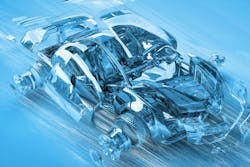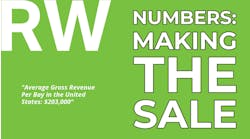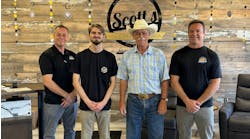After 52 straight months, hundreds of hours of researching and interviewing, and pages upon pages of information compilation, two truths stick out to Derek Kaufman.
One: The emerging trend of vehicle connectivity is an insanely daunting topic for the automotive aftermarket to grasp and fully understand—Kaufman should know, as he was commissioned by the Auto Care Association (ACA) to track the progress of telematics in the automotive aftermarket through the above mentioned report, entitled the “Telematics Trendline.” Using telematics to connect with consumers’ vehicles is a promising business model and will undoubtedly become the norm in the near future, he says. The technology can completely reshape this industry, and every one of the biggest players—the dealerships, the automakers, the MSOs, and the connected car companies—realizes that and plans on going all in.
And, more importantly, two: Your shop has boundless potential to be a major player in that arena.
In fact, Kaufman—managing partner for the automotive aftermarket consultant group Schwartz Advisors LLC—is so sure of it, that when confronted with skepticism that the average independent shop owner can even begin to compete and collaborate with those behemoths, and when confronted with the fact that very few independent shops have started using telematics while many dealerships and MSOs have already embraced it, he doesn’t hesitate in saying:
“The automotive aftermarket is one of the most innovative places you could ever be a part of,” he says. “I’m just amazed when I see these people and their ability to figure things out.”
So after all those hours, days, weeks, months, years of crafting his reports, Kaufman’s confidence in your abilities says a lot. Major influencers from virtually every segment of the automotive industry (many of whom spoke with Ratchet+Wrench for this article) are all part of this seismic shift, and Kaufman says your capacity to compete in the telematics macrocosm only rests upon your understanding of its various parts—the legislation, the dominant stakeholders, the minutiae of the technology, and the avenues for success for your shop.
It is, to borrow a term from Kaufman’s 52-part report, a “trendline.” Telematics is exiting its infant stages, and its path is slowly starting to take shape. So, where does the independent shop owner fit in that trendline? Well, that’s up to you.
1) The Technology
The term “telematics” can be intimidatingly difficult to succinctly define, as it refers to a wide spectrum of computers and wireless telecommunications technology that delivers information over a network. For vehicles, that definition covers a wide array of amenities and features, including real-time diagnostics, hands-free phone calls, in-car Wi-Fi services, collision avoidance systems, and adaptive cruise control.
But, for automotive repair, its most beneficial form is something extremely specific, Kaufman says. Using a dongle hookup in a vehicle’s OBD-II port, auto repair shops can directly connect with drivers, detect trouble codes, and utilize vehicle information to determine if repairs and service are needed. The shop can then follow up with drivers and arrange appointments.
2) The Dealership Advantage
When you’re dealing with an issue this complicated and intricate, one person won’t do—you need a team.
The issue? Realizing the opportunity telematics presents, automakers have seized upon the technology to connect diagnostic information with dealerships, who then track vehicle data and schedule appointments accordingly.
Aaron Lowe, senior vice president of regulatory and government affairs for ACA, fears this strips power from the consumers, who then have little to no control over where their vehicle information goes.
“In our opinion, it’s important that consumers are aware that when they buy a car, their vehicle is sending data to the manufacturer. That awareness is extremely low right now,” Lowe says. “What we’re contending is the car owner not only owns data, but should also be controlling where it is sent.”
Where should it be sent? A customer’s preferred automotive repair shop—which means you need to be equipped to handle the technology as consumer awareness regarding the transfer of vehicle information increases.
That’s why representatives from various automotive service organizations—including the Automotive Service Association (ASA), the Automotive Aftermarket Suppliers Association (AASA), the American Automobile Association (AAA) and the Equipment and Tool Institute (ETI)—came together to form the Telematics Task Force. Working with vehicle manufacturers, component suppliers, standards organizations and telematics application developers, the group’s goal is to ensure open access to automotive telematics technology, vehicle connection and service information for both vehicle owners and aftermarket service providers.
While Lowe isn’t aware of any current legislation that would reverse this dilemma, he says the awareness within Congress has been exponentially raised.
Shop owners should be doing their part, he says. If you’re a member of any of the above organizations, he says you can inquire about how to offer your assistance on a legislative level. You can also track the websites for ACA (autocare.org) and the Telematics Task Force (aftermarkettelematics.org) to keep up on any activity.
3) Consumer Awareness
Because the average vehicle owner’s awareness of the ins and outs of telematics is currently so low, Lowe says educating consumers on the technology will be crucial in setting independents apart from dealerships.
Mike Calkins, manager of technical services for AAA, agrees. With more than 35 years of experience in the industry researching repair information and emerging vehicle technologies for people within the industry, his new consumer-focused position has given him insight into just how little the average car owner understands the technology within his or her car.
“If you start talking about diagnostic issues involving electronically controlled systems, you can’t get three words into the first sentence without their eyes glazing over,” Calkins says. “What they really need to understand is the impact and implication of this technology.”
It’s a strange crossroads, Calkins says. Vehicle reliability, in terms of engines and transmissions, has gone up every year since 2007, according to J.D. Power’s U.S. Vehicle Dependability Study. However, consumers have grown increasingly dissatisfied with their vehicles, due to frustration with collision protection, driver assistance, Bluetooth, navigation, etc.
As consumers become increasingly upset with certain makes, it affects brand loyalty and, in turn, affects trust in dealerships. Both Calkins and Lowe see this as an opportunity for independent shop operators to offer guidance. Here are a few of their tips:
• Make a landing page on your website that explains how the OBD-II devices work. As more and more consumers learn about telematics, it will improve your SEO performance and paint your shop as a trustworthy expert.
• Market your telematics expertise regularly on social media, providing blog updates on the technology and how it’s improving your ability to keep customers safe.
• Hand out flyers to each customer that leaves your shop explaining the technology and how it can lead to more timely repairs and preventative maintenance.
4) The MSO Advantage
Here’s the thing, though: While there are theories and thoughts on best practices, it’s still unclear how to best sell telematics to the average consumer. Not ACA, not Derek Kaufman, and not even a 450-shop network like Meineke knows—which the company’s president, Danny Rivera, freely admits.
But then again, he plans on finding out soon with the MSO’s brand-new telematics device, Revvy.
As part of a partnership with T-Mobile, Revvy is a simple plug-in device for OBD-II ports that allows a customer to sync a vehicle with his or her preferred Meineke shop. The telematics system launched in January 2017, and has only sold over 100 units units as of the publishing of this article. But that, Rivera says, is because Meineke is slowly rolling out the technology in three markets—Charlotte, N.C., Las Vegas and Seattle—in order to gauge both how it will fit into the Meineke shop model and how to best educate consumers on the device.
“We’re trying to figure out what features and benefits resonate with consumers,” Rivera says. “Then it’s a matter of deciding what channels are best for conveying that. If it’s widely accepted with open arms and people love it, then it lends itself to mass media campaigns. Then again, if it’s too much information, education might need to take place on a customer-to-customer basis.
“That’s one of the difficult things for being so far out ahead on something, is that there’s not a lot of best practices already in place.”
5) The Opportunity For Independents
MSOs clearly have an advantage when it comes to partnering with major companies like T-Mobile. But it also opens the playing field for both independents and smaller telematics players, Gary Tucker says.
And, as president of Zubie, a connected-car platform and telematics provider, he’s in a pretty good position to make that statement.
In fact, he’s so willing to make it work with the average shop, that he’s extending an open invitation to any aspiring independent shop operator:
“I would love to work with a leading shop to develop something,” Tucker says. “We’ve got the ability to give them a platform, to help them strengthen a relationship with consumers. We want to work alongside progressive shop owners.”
That quote is significant for two reasons. First, Zubie has, thus far, marketed itself exclusively to fleets and dealerships. Tucker says most telematics companies follow that trend because the dealership and fleet models tend to be extremely similar, while independent repair shops have more nuance to their operations.
On top of that, it has been much easier to sell OBD-II devices to dealership and fleet customers, versus your average skeptical driver, who tends to need convincing about the transfer of vehicle information. All of that means Zubie can build a one-design-fits-all for dealerships and fleets, but needs a close working relationship with independent shop owners to figure out what works best for them.
The second reason that quote is significant? At the time of his interview with Ratchet+Wrench, Tucker was just eight days into his presidency. He has made it one of his main goals to spread the technology to independent shops.
“Reach out to me and let’s make it work,” he says to shop operators everywhere.
6) The Major Companies
Actually, Kaufman says most telematics companies are open to working with independent shops—you just have to know where to start.
For each Telematics Trendline released monthly through ACA, Kaufman reported on two, three, sometimes five or six different companies influencing telematics in the automotive industry. Over the course of almost five years, many names came and went. And by the time he published his final report—which was just a few months ago—Kaufman had a pretty clear idea of the five major players in telematics to watch for as the technology really gains traction:
Innova
If you know Jim Dykstra, the owner of the $3.8 million, three-shop Dysktra’s Auto in Grand Rapids, Mich., then you might know a thing or two about his influence on telematics in the automotive aftermarket. As the former president of Aftermarket Telematics Technologies—recently acquired by Innova—he had a major hand in creating Vehimatics, an influential player in the connected car technology arena, Kaufman says.
Kaufman claims a purchasable product is due soon, and that it is specifically geared toward the average shop owner looking to break into telematics.
“The cool thing about that package is it was written by Jim, and he wrote it with the shop in mind,” Kaufman says. “So many of the code packages are written by coders that know nothing about automotive aftermarket.”
Geotab
Like most of the most prominent companies in vehicle telematics, Geotab specializes in the area of fleet management when tracking vehicles. Using its GO7 device, the Toronto-based company not only offers access to the OBD-II port, but also systems and software that help track vehicle metrics in an effort to get the most out of your telematics system.
Verizon
Perhaps the most popularly advertised connected car system, Verizon unveiled Hum last year, targeting parents that want to better track their children’s use of the family vehicle. For shop owners, however, it also offers access to vehicle diagnostics that can be utilized just like any other company’s software.
Verizon has also majorly focused on business-to-business advertising for fleet servicing through its Networkfleet system.
Automatic
While this is another company that is currently still in development, Kaufman assures Automatica will be a big name, as it made a point of partnering with numerous prominent consumer apps used and offers a wide array of methods for tracking your customer database.
Vinli
Another new company, Kaufman says Vim.ly has formed its own “app ecosystem” aimed at both repair businesses looking to expand its telematics influence and consumers searching for nearby auto service.
7) The Ground Floor
There’s only one step left, Kaufman says—taking the plunge.
He understands the hesitation by independents thus far, as they’ve had difficulty obtaining an ROI on the technology.
“It’s not that the ROI can’t be great enough,” he says. “It just has not been defined well enough. You find people getting into it for the novelty of it, and then are gone in three months. Like any marketing piece, it needs time to become part of your shop model long-term to show an ROI.”
That’s why he suggests a model similar to Troy Kaplan’s, whose shop, TGK Automotive in Hugo, Minn., has embraced telematics through the aforementioned Networkfleet system hosted by Verizon.
The important factor to note, however, is that TGK Automotive didn’t start out going after fleet work—Kaplan adapted when necessary.
Because a clear model for how telematics will work within the average independent shop has yet to exist, Kaufman says it will be a work in progress for a few years. He suggests going the route of Kaplan, who uses a streamlined, widely accepted, well-defined approach designed for fleets.
“We have a fleet account that has 40-50 vehicles,” Kaplan says. “It’s simplified things for staying on top of the maintenance and coordination with the fleet manager for scheduling maintenance, oil changes, flushes, etc.”
The fleet account hasn’t disrupted operations in any major way. Kaplan will track the fleet vehicles and schedule work throughout the week, and then arrange his existing customer database around that work.
The real advantage here? Kaplan is, at the very least, getting his hands on the technology, learning how it works and researching ways he can bring it into his business for the everyday driver.
This, it turns out, is Kaufman’s biggest piece of advice, and the real reason he believes in your shop’s ability to succeed: Even in the face of all odds, the independent repair shop owner’s capacity to adapt and innovate is second to none, he says. It’s just a matter of embracing the unknown and finding what works for your team.



